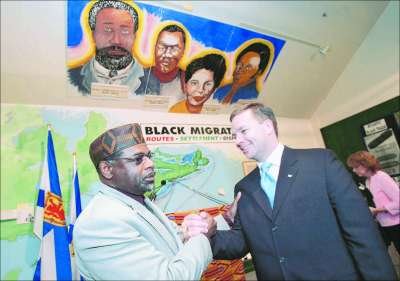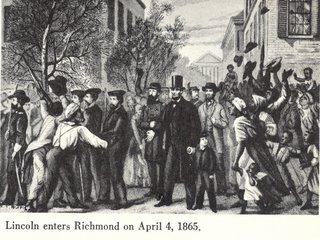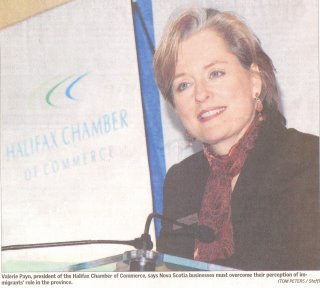 Commentary:
Commentary:The barbarians are burning down Black shrines: the Black Cultural Centre and the Black Loyalist Heritage site in Birchtown, Shelburne County.
But as the new Nova Scotia premier gives the Black Cultural Centre its $200,000.00 grant to fix its roof would it be out of place to mention that there are racists out there in HRM trying to burn it down? Would it be out of place, or is it just plain stupid not to mention it?
Keep it quiet until we get the money and then keep it quieter because they may take it back.
We just better shut our mouths and go back to doing what we do best. Be silent! They tell us, asking: can't you see that grant we are getting?
Respect, we really don't need, but a new roof is worth a hand shake with the new Nova Scotia premier. Wow! A picture is worth two thousand words.Be assured that the arsonists are not exactly making a getaway for they know the authorities do not want to catch them; catching them would bring far too much unwanted attention and much too much focus on an issue HRM would sooner forget and does not acknowledge exists.
It is well-known though that HRM will pay hush money. Maybe the arsonists should turn themselves into HRM. They too can get mountains of that hard earned taxpayer money for their effort at being silent about what happened. Unjustly the arsonists might even get as much as did poor Mr. Symonds for far less effort. But, the public could not handle knowing the details of Mr. Symonds' racial nightmare at the hands of HRM’s “diversity” officials.
We are not allowed to know the details of the settlement and just how low HRM can really go. We might even imagine that we Canadians are living in South Africa’s Johannesburg, before the release from prison of Nelson Mandela. You might have to use your imaginations, but I feel confident that you can do it. But more to the point, were the truths about HRM's true prejudices really known, the myths would vanish and the truth would scare away the multicultural immigrants HRM finds it so hard to attract. All the dreams and all the illusions sourrounding Pier 21's immigrant history would simply vanish like the immigrants to other parts of Canada and the United States. God knows we need more immigrants in HRM to keep the myths alive.
Everyone in HRM is in denial about even the existence of racism. That is, everyone but the new, middle-aged novelist Stephen Kimber, who has recently written a fiction novel about its existence but of course only among the fictional characters who bear no resemblance whatsoever to anyone now living or dead who may have resided in HRM. As you can tell nothing is certain. Of course the names of the characters are not real because the story is supposed to be about racism in HRM, which is just true fiction and of course Africville never happened; it too must have been a fictional place since the characters and the story come out of Stephen Kimber’s imagination.
It is quietly rumored that HRM is an acronym standing for Home Racists’ Municipality. But you will not have to look too far into the 2006 Doers’ and Dreamers’ Guide to Nova Scotia’s tourism industry to find it. You know tourists have been heard to ask: Where did all the Black folks go? Is there Apartheid in HRM?
On this question, and others, the Black and White leadership of HRM is silent. Among those who are reported to be preparing statements but are not now available for comment are: the leader of the Nova Scotia human rights commission; the mayor of the HRM; the Premier of Nova Scotia; the Black candidates hovering in the background for political leadership of some sort, in fact, any sort; and the chairwoman of HRM's race-relations committee.
Cheezz!! Cheezz!! Flash! Flash! That's a good photo op.
Squeak! Squeak! Squeal the little Black and White mice as they run in circles around their barrel called HRM. The faster they go, the smaller the barrel becomes, until eventually there’s an incident as on July 19, 1991 when in Rosa’s Lounge tempers flared and the police, rioters and the entire community wondered how it all happened. We all know how it happens, don't we and we know why. I remember, do you remember the finger pointing?
If we want to stop the rat race we are going to have to deal with real issues, or face the music. To do this, we need real leaders, not cartoon figures.
As Always, Well wishes,
F. Stanley Boyd
See the stories below, they tell us why we are not ready yet to meet this challenged called racism.
The photo above appeared in the Chronicle Herald on Saturday, April 08, 2006, page B2. Above: Premier Rodney MacDonald shakes hands with Henry Bishop, chief curator of the Black Cultural Centre, on Friday after giving the centre $200,000 to fix its roof.(Tim Krochak / Staff)
City hall quietly closes book on racism caseThe Halifax Chronicle Herald, Thursday, April 06, 2006 Page 1.
By MICHAEL LIGHTSTONE City Hall Reporter
Halifax city hall settled a human rights complaint — once described as "a serious personnel issue" — behind closed doors this week, about five years after a former municipal employee was targeted by a co-worker because of the colour of his skin.
The agreement, ratified by regional council Tuesday night, means a complaint Randy Symonds filed with the Nova Scotia Human Rights Commission about his treatment at Metro Transit has been terminated, the man said Wednesday.
Mr. Symonds said he lodged a complaint with the commission around 2002 and was notified a few months ago that it was scheduled to be heard by a human rights board of inquiry.
"It was supposed to go to a tribunal at the end of this month," said the 43-year-old Dartmouth resident.
The complaint stems from evidence that Mr. Symonds, who’s black, was victimized by a bigoted colleague while working in the stores department of the city’s public transit service in Burnside Park. A confidential report done for Halifax Regional Municipality about three years ago said he wasn’t the only one stung by bigotry on the job.
"This investigation concludes that the complainants have been subjected to racial harassment," the June 2003 report said. The document was prepared for the municipality’s personnel director, Louis Coutinho, who has acknowledged "this is a serious personnel issue."
Mr. Symonds, who said he has battled severe stress and anxiety due to the discrimination he experienced, may be settling with his former employer but he’s not at all pleased with the way the municipality handled his complaint. He said the trouble started back in 2001.
"The city’s got quite a ways to go as far as employment equity and racism" are concerned, Mr. Symonds told The Chronicle Herald.
Wayne Anstey, the city’s deputy chief administrative officer of operations, said the municipality "did take steps within the workplace in terms of staff training . . . with respect to race relations." He said the city "obviously doesn’t condone racism in the workplace, and we do what we can to try and prevent it."
Though he has received an apology from the co-worker — who was initially fired by Metro Transit, then re-hired in April 2002 — Mr. Symonds feels racist treatment he endured during the three years he worked for the city has damaged his quality of life.
Aside from being the victim of derogatory comments, the man was taunted and teased and subjected to racist graffiti in a workplace washroom. Mr. Symonds has also alleged he was threatened by the offender after he complained to a supervisor.
At one point, Halifax Regional Police were called in to probe a complaint from the municipality regarding a letter the city’s co-ordinator of diversity programs received. A senior HRM manager said the letter was "hate correspondence." No charges were ever laid.
Terms of the human rights settlement, which were discussed in camera before Tuesday’s council meeting at Halifax city hall, have not been disclosed. Mr. Symonds said the deal was reached between his lawyer and the municipality’s legal staff, and he’s bound by "a gag order" not to release details.
Coun. Mary Wile (Clayton Park West) made a brief statement — a recommendation for the councillors — at the end of the council session about the settlement, saying the Amalgamated Transit Union must also ratify the agreement. She said details aren’t to be released.
Mr. Anstey said in an interview that "it’s a confidential matter between us and the claimant," and both sides have agreed to keep terms of the agreement secret.
Asked why he agreed to settle the matter shortly before it was to be dealt with by a human rights tribunal, Mr. Symonds, who’s unemployed, said depleted finances forced his hand.
His case, which made headlines locally and attracted the attention of a national radio show, follows the high-profile friction between professional heavyweight boxer Kirk Johnson and Halifax police. The black athlete’s car was stopped by police several years ago and was seized by a white officer.
Mr. Johnson, 34, won a human rights judgment covering the traffic stop incident and got an apology from Police Chief Frank Beazley. The chief also pledged to make race-relations improvements in his department.
(
mlightstone@herald.ca)
Councillor: Committee doesn’t handle racism casesThe Halifax Chronicle Herald, Saturday, April 08, 2006 Page B1.
By MICHAEL LIGHTSTONE City Hall Reporter
Racism cases such as that of a former municipal employee who recently settled a human rights complaint with Halifax city hall aren’t handled by the municipality’s community and race relations advisory committee, says a regional councillor who has twice served on the committee.
Councillor David Hendsbee (Preston-Lawrencetown-Chezzetcook) said Friday the group deals with employment equity issues within Halifax Regional Municipality’s workforce and promotes diversity in local organizations but doesn’t handle personnel matters.
He said the best way for the city to approach a race-based dispute between a municipal worker and his or her employer is through the labour-relations process.
"I don’t recall any particular (employee’s) case being brought to the attention of the committee," said Mr. Hendsbee, who has served with the volunteer group for several years spread over a couple of stints on council.
"We always spoke more in general terms of topics and issues but not of personnel cases," he said.
Mr. Hendsbee was commenting in the wake of a settlement this week between city hall and former Metro Transit worker Randy Symonds. The 43-year-old Dartmouth man, who’s black, was victimized by a bigoted co-worker when he worked in the public transit company’s stores department in Burnside Park.
Details of Mr. Symonds’s settlement have been kept secret by Halifax regional council; the agreement still has to be ratified by the Amalgamated Transit Union. Mr. Symonds had filed a complaint with the Nova Scotia Human Rights Commission, but his settlement terminated it.
Asked if the municipality’s race relations committee ever dealt with the high-profile case of heavyweight boxer Kirk Johnson and police harassment, Mr. Hendsbee said the traffic stop incident was mentioned when it was in the news several years ago.
But the councillor said committee members didn’t focus on the athlete’s situation, instead they focused on the relationship between Halifax Regional Police and metro’s black residents. There has been distrust and friction between the two sides in the past.
"Mr. Johnson’s situation brought a focus on that topic in more general terms," Mr. Hendsbee told The Chronicle Herald.
According to the municipality’s website, the race relations committee is to meet the first Thursday of each month. It didn’t meet this week due to a lack of a quorum, a city hall staffer said, but held a session in March. The February meeting was also cancelled because not enough members attended.
Committee chairwoman Betty Thomas couldn’t be reached Friday.
(
http://www.halifaxherald.com/NovaScotia/)
Struggle continuesVoice of the People - The Halifax Chronicle Hearald, Wednesday, April 05, 2006 page B
As I write this letter at 12:30 a.m. on April 1, the office building at the Black Loyalist Heritage site in Birchtown, Shelburne County, is ablaze. The fire appears to have started on the front deck. Strangers were noted driving through the community moments before. The building is only five years old.
The Black Loyalists, who arrived in Shelburne in 1783 as freed black slaves along with the Empire Loyalists, were the targets of a labour dispute between the white landowners and disbanded soldiers employed as white labourers. This kerfuffle resulted in what is now historically known as North America’s first race riot. White labourers tore down and burned the temporary shacks of the blacks and drove them out of town to the area of Birchtown.
The Black Loyalist Heritage Society has engaged in a 20-year struggle to gain recognition of the Black Loyalists and to develop this historic site. The office building is the workplace for the planning of this development as well as the genealogical data centre.
Until an accurate report of the cause of the fire is received, we can only wonder whether we are witnesses to another chapter in the social history of the Black Loyalists, or an April Fool’s distorted sense of humour.
Sharon Oliver,
Black Loyalist descendant,
Wolfville
Woman worried racists targeting black landmarksThe Halifax Chronicle Herald, Saturday, April 08, 2006 Page 1.
By RICK CONRAD Staff Reporter
With two African-Nova Scotian landmarks vandalized in the past two months, Sharon Oliver can’t keep quiet about what she considers hate crimes.
"The black community needs to take more responsibility and keep this front and centre," she said in an interview Friday.
"The quieter it’s kept, if we acquiesce to these kinds of actions, then it’ll continue to happen."
Ms. Oliver was reacting to the torching of the Black Loyalist Heritage Society’s office in Birchtown last week, along with many priceless historical artifacts. That came on the heels of the Black Cultural Centre in Dartmouth being blasted by six Molotov cocktails in late February. That caused about $1,500 damage, she said.
She believes different people are likely responsible, but the link the crimes share is the buildings’ obvious importance in each community.
"They didn’t target the Ross Museum, they didn’t target one of the other 18th-century buildings down on the dock (in Shelburne); they targeted the Black Loyalist Heritage Society," said Ms. Oliver, who lives in Wolfville but is a member of the heritage society’s board and helped plan the Birchtown site.
"It’s very sad. When I was phoned Friday night and (was told) the building was engulfed in flames, I really couldn’t say too much. I could see this small little community group with 20 years of work going up in flames, and I was dismayed."
Sgt. Barry MacLellan of Shelburne RCMP said Friday that two members of the detachment are "actively investigating" the Birchtown blaze, which appears to have been deliberately set.
"There was some indication that it might have had some racial overtones," he said. "However, at this point in time, we haven’t uncovered any evidence to suggest that."
Richard Gallion, the heritage society’s vice-president, said Friday he didn’t want to comment on whether the blaze was racially motivated, although he admitted "it’s in the back of every-body’s mind."
He estimated it could take all of the building’s $140,000 insurance to replace it and its contents, including original photos from settlers’ descendants "that are totally gone."
"It’s a great loss — for everybody," Mr. Gallion said, though the society is already planning to rebuild.
Henry Bishop, chief curator of the Black Cultural Centre, said he didn’t want to discuss the February incident.
"I don’t want to change the whole atmosphere of this," he said Friday after an announcement of a badly needed $200,000 from the province to fix the centre’s roof. "We’re beyond that now."
Ms. Oliver said she finds the Birchtown blaze especially suspicious since the society has plans to improve on the site, founded in 1783, to make it a more enduring monument to the largest settlement of free blacks outside Africa.
"One questions whether racism is still existing in this day and age. Of course it is. And this is evidence that it is. I know that the white population is very reluctant, particularly the media and the police, to label anything, and yet we’re not reluctant to label something with swastikas put on it."
(
http://www.halifaxherald.com/Front/)
(
asmith@herald.ca)
With Amy Smith, provincial reporter










